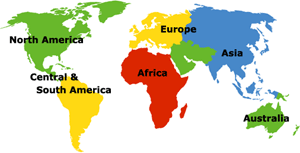 Foreign-born players captured more than half of 2004’s PGA Tour tournaments (26 of 48), thanks in large part to Vijay Singh’s nine wins. Meg Mallon pointed out that, in this, the men have long trailed the women: “We’re already there. There are good tours in Europe and Japan, but they send their best to the United States. We’ve been international for over 10 years.”
Foreign-born players captured more than half of 2004’s PGA Tour tournaments (26 of 48), thanks in large part to Vijay Singh’s nine wins. Meg Mallon pointed out that, in this, the men have long trailed the women: “We’re already there. There are good tours in Europe and Japan, but they send their best to the United States. We’ve been international for over 10 years.”
Heading into this weekend’s ADT Championship 20 of 31 LGPA events have been won by international players. Annika Sorenstam is responsible for seven of those, and the remaining wins were split among players from South Korea, England, Scotland, Mexico, Australia, and the Philippines.
It’s old hat on the LPGA Tour, which featured 24 international winners. In 2000, only six events were won by American-born players. The last time the Americans won more than international players? 1997.
Internationalization is all the rage, these days. Arnold Palmer agrees, and said in a speech at the World Golf Hall of Fame on Monday that “The future of this game is international. It’s something we have to recognize and enjoy.”
Palmer helped to kick off the internationalization trend when he travelled to the Open Championship in 1960. He finished second and won the next two, boosting the Open to a place of prominence. “What was the reason for going? It was to create a relationship I thought the world needed,” Palmer stated.
44 years later, the US Tours are a mixture of nationalities. 18 of The ADT Championship’s 30 players are foreign-born. The PGA Tour’s Tour Championship likewise featured 15 foreign players and 16 Americans.
Is American golf on the slide? When compared to the rest of the world, sure. But Americans still accounted for 22 of the PGA Tour’s 48 wins. Fiji was second with nine (guess who), and Australia finished in third with seven. American women won 11 events, Sweden eight, and South Korea took four.
With all of these foreign-born men and women playing – and winning – on the US Tours, what will become of the international tours? More and more Europeans are coming to the US – Sergio Garcia, Justin Rose, Luke Donald, Darren Clark, Lee Westwood, Padraigh Harrington, Adam Scott, Shigeki Maruyama – the list goes on.
The LPGA is doing its part. Tour stops are planned for seven countries next year: the United States, Canada, Japan, South Korea, France, England, and Mexico. That doesn’t mean that the LPGA Tour is going to become an international tour – LPGA Commish Ty Votaw sees the Ladies European Tour and the Japanese LPGA as great places for developing players.
International players, America is open, wealthy, and waiting.
